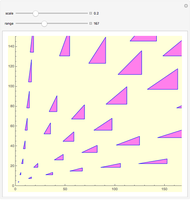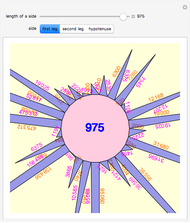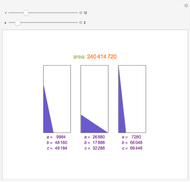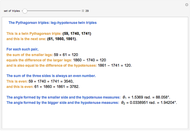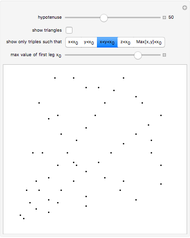Primitive Pythagorean Triples 4: Ordered Tree Matrices

Requires a Wolfram Notebook System
Interact on desktop, mobile and cloud with the free Wolfram Player or other Wolfram Language products.
Given a primitive Pythagorean triple (PPT), three new PPTs, which we call children of the original, are generated by multiplying the original on the right by three fixed matrices called Hall matrices. Moreover, any PPT can be generated by a series of such right-multiplications starting from the PPT  . Equivalently, we can generate the three new PPTs by right-multiplying "redundant forms" of the original PPT by a single matrix. The PPT
. Equivalently, we can generate the three new PPTs by right-multiplying "redundant forms" of the original PPT by a single matrix. The PPT  has a total of eight redundant forms,
has a total of eight redundant forms,  , but only the four redundant forms,
, but only the four redundant forms,  , are required.
, are required.
Contributed by: Robert L. Brown (November 2010)
Open content licensed under CC BY-NC-SA
Snapshots
Details
Let  be a PPT, that is,
be a PPT, that is,  ,
,  , and
, and  are positive integers such that
are positive integers such that  with
with  . A primitive right triangle has sides that are a PPT.
. A primitive right triangle has sides that are a PPT.
Redundant form means that the PPT definition is relaxed to allow negative values.
Each PPT can be represented by a unique base-3 number called the PPT's ID number. The three children of a PPT have ID numbers formed by appending 0, 1, or 2 to the ID number of the PPT. The parent of a PPT has an ID number formed by dropping the last digit of the PPT's ID number.
Let  be a PPT. When post-multiplied by any one of four 3x3 matrices
be a PPT. When post-multiplied by any one of four 3x3 matrices  ,
,  ,
,  , or
, or  , a new PPT is the result. These four matrices are:
, a new PPT is the result. These four matrices are:
 ,
,  ,
,  ,
,  .
.
If a suitably selected redundant form of  is used, then
is used, then  is the only matrix needed, as shown by clicking the matrix control "P". Also,
is the only matrix needed, as shown by clicking the matrix control "P". Also,  gives a redundant form of the parent PPT, because
gives a redundant form of the parent PPT, because  .
.
However, the proper redundant form can be calculated by first multiplying  by
by  ,
,  , where
, where
 ,
,  ,
,  ;
;
that is,  ,
,  , and
, and  . Set
. Set  ,
,  , and
, and  . These are shown with the matrix control set to
. These are shown with the matrix control set to  " and
" and  derivation".
derivation".
The Demonstration "Primitive Pythagorean Triples 2: Ordered Pairs" shows that adding  to each element of
to each element of  accomplishes the same thing as multiplication by
accomplishes the same thing as multiplication by  .
.
Define  ; then
; then  and
and  , where
, where  is the 3×3 identity matrix.
is the 3×3 identity matrix.
Any PPT can be obtained by post-multiplying  or
or  by a unique chain of
by a unique chain of  matrices. Their subscripts spell out a unique PPT ID number, as shown in "Primitive Pythagorean Triples 3: Ordered Tree Graph".
matrices. Their subscripts spell out a unique PPT ID number, as shown in "Primitive Pythagorean Triples 3: Ordered Tree Graph".
MathWorld's "Pythagorean Triple" (Wolfram MathWorld)and other sources use  ,
,  , and
, and  , as in [1].
, as in [1].
References
[1] B. Berggren, "Pytagoreiska trianglar" (in Swedish), Tidskrift för elementär matematik, fysik och kemi, 17, 1934 pp. 129–139.
[2] A. Hall, "Genealogy of Pythagorean Triads," Mathematical Gazette, LIV(390), 1970 pp. 377–379.
[3] Formulas for generating Pythagorean triples
[4] H. Lee Price, "The Pythagorean Tree: A New Species", 2008 http://arxiv.org/abs/0809.4324.
Permanent Citation












